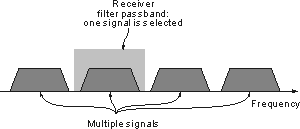OFDM is of great research interest in laboratories all over the world. It has already been accepted for the new wireless local area network. Also, it is expected to be used for wireless broadband multimedia communications as well.
Data rate is really what broadband is all about. The new standard specifies bit rates of up to 54 Mbps. Such high rate imposes large bandwidth, thus pushing carriers for values higher than UHF (Ultra High Frequency) band. For instance, IEEE802.11a has frequencies allocated in the 5- and 17- GHz bands.
OFDM, orthogonal frequency division multiplex is a rather different format for modulation to that used for more traditional forms of transmission. It utilises many carriers together to provide many advantages over simpler modulation formats.
What is OFDM? – The concept
An OFDM signal consists of a number of closely spaced modulated carriers. When modulation of any form – voice, data, etc. is applied to a carrier, then sidebands spread out either side. It is necessary for a receiver to be able to receive the whole signal to be able to successfully demodulate the data. As a result when signals are transmitted close to one another they must be spaced so that the receiver can separate them using a filter and there must be a guard band between them. This is not the case with OFDM. Although the sidebands from each carrier overlap, they can still be received without the interference that might be expected because they are orthogonal to each another. This is achieved by having the carrier spacing equal to the reciprocal of the symbol period.

To see how OFDM works, it is necessary to look at the receiver. This acts as a bank of demodulators, translating each carrier down to DC. The resulting signal is integrated over the symbol period to regenerate the data from that carrier. The same demodulator also demodulates the other carriers. As the carrier spacing equal to the reciprocal of the symbol period means that they will have a whole number of cycles in the symbol period and their contribution will sum to zero – in other words there is no interference contribution.

Advantages
- Can adapt easily to bad channels.
- Robust against crosstalk between channels that are close together.
- Robust against Inter-symbol interference (ISI) and fading caused by multipath propagation
- High spectral efficiency
- There are good implementations available
- Few problems with errors that come from time synchronization.
- Tuned sub-channel receiver filters are not required (unlike conventional FDM).
Disadvantages
- Problems with Doppler shift.
- Synchronizing frequencies can be problematic.
- Sensitive to frequency synchronization problems.
- High peak-to-average-power ratio (PAPR). This needs linear transmission circuits; they need a lot of power.
- Loss of efficiency caused by Cyclic prefix/Guard interval.
Application
With OFDM, high data rate is achieved .So it is basically used in Digital audio and terrestrial TV broadcasting, Wireless LAN’s (802.11a,g and n), High-speed cellular data etc.
Sanjay Mangal
B.Tech III (ECE)
mangalsanjay25@gmail.com